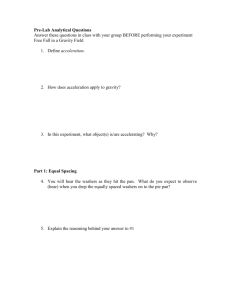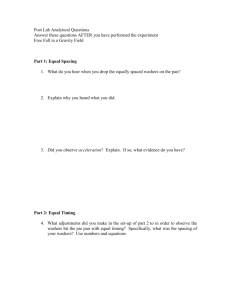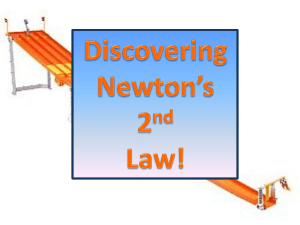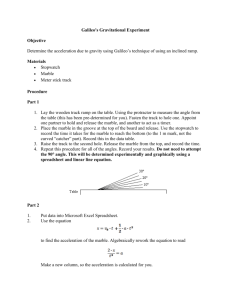Acceleration of Gravity Lab – Advanced Version In this lab you will
advertisement
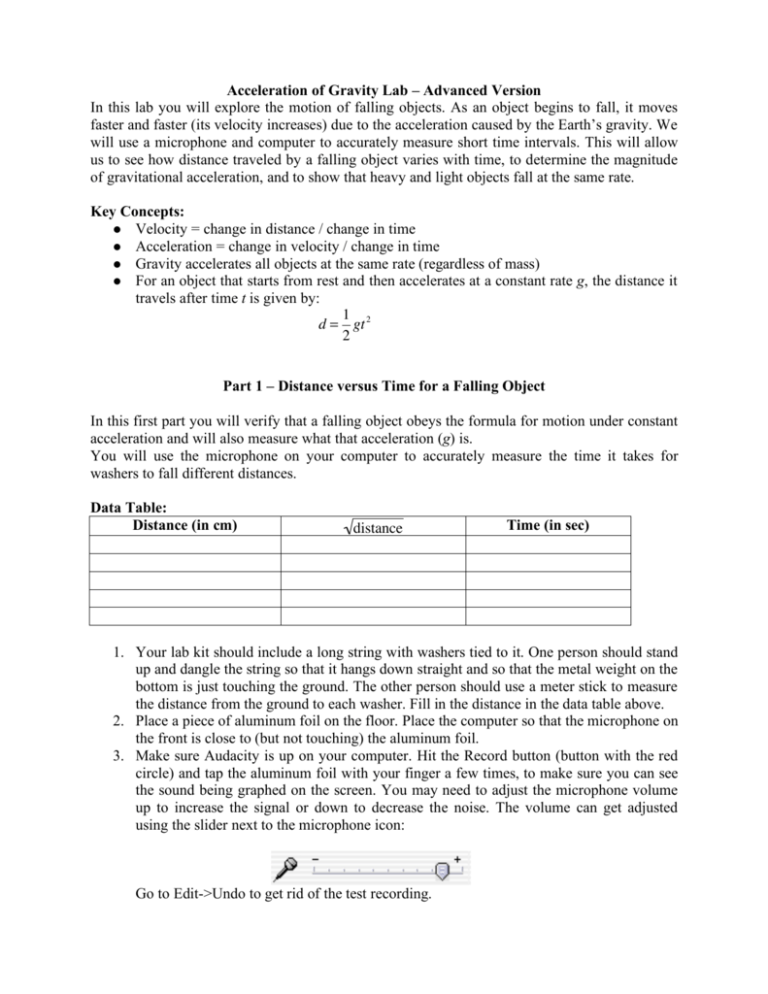
Acceleration of Gravity Lab – Advanced Version In this lab you will explore the motion of falling objects. As an object begins to fall, it moves faster and faster (its velocity increases) due to the acceleration caused by the Earth’s gravity. We will use a microphone and computer to accurately measure short time intervals. This will allow us to see how distance traveled by a falling object varies with time, to determine the magnitude of gravitational acceleration, and to show that heavy and light objects fall at the same rate. Key Concepts: Velocity = change in distance / change in time Acceleration = change in velocity / change in time Gravity accelerates all objects at the same rate (regardless of mass) For an object that starts from rest and then accelerates at a constant rate g, the distance it travels after time t is given by: 1 d = gt 2 2 Part 1 – Distance versus Time for a Falling Object In this first part you will verify that a falling object obeys the formula for motion under constant acceleration and will also measure what that acceleration (g) is. You will use the microphone on your computer to accurately measure the time it takes for washers to fall different distances. Data Table: Distance (in cm) distance Time (in sec) 1. Your lab kit should include a long string with washers tied to it. One person should stand up and dangle the string so that it hangs down straight and so that the metal weight on the bottom is just touching the ground. The other person should use a meter stick to measure the distance from the ground to each washer. Fill in the distance in the data table above. 2. Place a piece of aluminum foil on the floor. Place the computer so that the microphone on the front is close to (but not touching) the aluminum foil. 3. Make sure Audacity is up on your computer. Hit the Record button (button with the red circle) and tap the aluminum foil with your finger a few times, to make sure you can see the sound being graphed on the screen. You may need to adjust the microphone volume up to increase the signal or down to decrease the noise. The volume can get adjusted using the slider next to the microphone icon: Go to Edit->Undo to get rid of the test recording. 4. Two students should work together to carry out the experiment: Person 1: dangle the string over the piece of aluminum foil so that the washer near the end is just touching the foil. Stand on a chair if necessary. Person 2: hit the record button on the computer and signal to Person 1 that you have done so. Person 1: After you get the signal from Person 2, let go of the string. The washers should fall one by one onto the foil, with each one making a sound when it strikes. Persion 2: Stop the recording. 5. Look at the Audacity display and make sure that you can see 5 peaks on the graph corresponding to each of the washers hitting the ground. If the signal looks too messy you may need to redo the experiment. 6. To find the time at which each washer hit the ground, position the cursor over the peak in Audacity (using the mouse or arrow keys). If necessary, use the zoom button below the microphone volume to better see the area with the peaks. Look at the bottom of the Audacity window. There should be a line that says “Cursor: “ followed by some numbers. This gives the time corresponding to the cursor. In your data table, fill in the time at which each washer hit the ground. Also fill in the square root of the distance fallen. The formula for an object falling under constant acceleration can be rearranged as follows: 1 2 d = gt 2 ! t = d 2 g (where d is the distance an object falls in time t) If your experiment obeys this formula then if you plot of the square root of the distance fallen versus the time you should get a straight line, with a slope of 2 /g . You will use Excel to find the slope of the line that best approximates your data. 7. Excel should be open on your computer. At the top of the first column, enter the square root of the distance (which you filled in for the table above). Next to that, in the second column, enter the times that you measured. Use the mouse to highlight the numbers that you entered. 8. In the menu at the top of the screen, go to Insert Chart. Under chart type, select “XY (Scatter)”. Click Finish. Excel will show a graph of your data points. 9. Click on the graph to select it. In the top menu, go to Chart Add Trendline. Make sure “Linear” is selected. Then click on the Options tab at the top and click on the box that says “Display equation on chart”. Click OK. Excel has now drawn the line of best fit for your points and has shown you the equation of that line. Fill in the equation for the line of best fit (remember, your y variable is time t and your x variable is square root of the distance, d ): t = _________ d + ____________ Does your data fall along a straight line? Why is there a non-zero intercept? What does that value correspond to? What is the slope of the line? Use the slope to calculate a value for the acceleration of gravity (g). (Remember, slope = 2 /g ) The real gravitational acceleration is 980 cm/s^2. What is the percent error in your measurement? (percent error = (measured-actual)/actual) Do the time intervals between the washers hitting the ground increase, decrease, or stay the same as more washers hit? What does this mean about the velocity of the string? If you changed the spacing of your washers to all be 20cm apart and then repeated the experiment, would you expect the slope of the line to change? Explain why not or in which direction? If you changed the spacing of your washers to 20cm apart, would you expect the time intervals between the different washers hitting the ground to change as compared to a 30cm separation? Explain why not or in which direction? (Only do this part if you are less than 45 min into the lab period. Otherwise, come back to it later if you have time) 10. Predict what the time interval will be between the 1st and 2nd washer hitting the ground if 1 they are spaced 20cm apart. (Hint: use d = gt 2 to calculate the time for the first washer 2 to fall and the time for the second washer to fall; then subtract) Retie the first 2 washers to be 20cm and 40cm from the ground and run the experiment to test your prediction. Predicted time for 1st washer _____________, time for 2nd washer ____________ Predicted time interval _____________________ Measured time interval ___________________ Percent error ________________ Part 2 – Gravity and Mass In this part, you will measure the acceleration of gravity in another way, and also look at the effect of the mass of the falling object. 1. Use a book to angle your paper towel tube to make a ramp near the edge of the table. Place a marble at the very edge of the table, right next to an open end of the tube. If you have trouble with the marble rolling away from the edge, use a piece of aluminum foil to make a slightly rough surface for it to lie on. 2. Roll another marble down the paper towel tube so that it knocks your first marble off the table. Place a piece of aluminum foil on the floor approximately where the first marble fell. Reset your ramp and marble at the edge of the table as before. 3. Just like in Part 1, one person should be in charge of recording, and one person should perform the experiment. Make sure the microphone of your computer is near the marble on the edge of the table. 4. Person 1: press the record button on Audacity Person 2: Roll the 2nd marble down the paper towel tube so that it knocks the first marble off the table Person 1: stop the recording 5. Look at the graph of sound which you recorded and find the peaks where the microphone heard the two marbles striking each other and where the first marble hit the foil on the floor. Zoom in and/or play back the recording if you aren't sure which peaks are the right ones. 6. Find the time interval between when the marble was struck and when it hit the floor. Repeat the experiment one more time and take the average. Time interval of fall, trial 1: ______________ Time interval of fall, trial 2: _____________ Average time to fall (t) : _____________ 7. Measure the height from the floor to the table. Calculate the acceleration of gravity from your experiment, by using 1 d = gt 2 2 Height fallen (d) : ______________ Measured acceleration of gravity (g) : ______________ 8. Now repeat the experiment, but this time use a ping-pong ball at the edge of the table. Note: you may have to adjust the aluminum foil to make sure the ping-pong ball strikes it when it falls! Time interval of fall, trial 1: ______________ Time interval of fall, trial 2: _____________ Average time to fall (t): _____________ Measured acceleration of gravity (g): ______________ (A) Was there a significant difference in the time of falling for the ping-pong ball versus the marble? Was there much of a difference in the acceleration of gravity? (B) Which traveled a greater distance overall in the time it took to reach the ground, the marble or the ping-pong ball? What does that mean about the horizontal velocity of each ball as it rolled off the table? (C) What would happen if you used a bigger book to make a steeper ramp (but still had the marble roll horizontally off the table) ? Time to hit the floor would: Horizontal distance the ball travels would: (Try the experiment, if you're not sure!) increase / decrease / stay the same increase / decrease / stay the same Challenge: Can you explain your answers to the previous two questions (B & C) using conservation of energy? (Note: the kinetic energy of a moving object is KE = 1 2 mv 2 and the potential energy of an object at height h is PE = mgh . The total energy of the system is conserved, which means the energy of the 1st marble as it rolls to the bottom of the ramp must equal the total energy of the two balls as they roll off the table)
